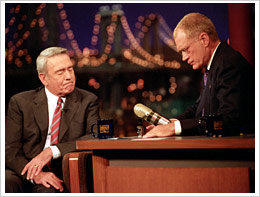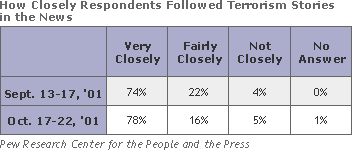 |
|
| On September 21, 2001, the Atlanta Braves and the New York Mets played the first major-league baseball game in New York after the September 11 attacks. Mets catcher Mike Piazza added the New York City Police Department (NYPD) logo and an American flag to his uniform. AP / Wide World Photos |
|
When we try to understand how the media cover terrorist incidents, the volume of coverage involved, we typically undertake a systematic content analysis of television, print, and radio coverage. There was no need to count the column inches or figure out the amount of television or radio airtime after September 11, since there was nonstop coverage for days. Literally, network television showed no other programming for the first five days. Not even commercials were shown. I cannot remember a longer stretch of time without commercials on television. Even the sports station either switched to crisis coverage or simply showed the American flag on its screen.
People who tried to get away from the crisis coverage basically had nowhere to go. For a while no sports events were held. When they resumed, you saw players wearing the caps of the New York police and fire departments. During interviews, people were asked about their feelings about the terrorist events. Suspended entertainment programs were sometimes different when they returned after 9/11. Letterman, Leno, and the other late-evening comedian shows could not find the right material to joke and laugh about. The first program of Letterman was very serious: He interviewed Dan Rather, a hard-nosed newsman. When the events of 9/11 came up, Rather broke down twice in tears.
 |
|
|
On the first broadcast of the Late Show with David Letterman after the September 11 attacks, Letterman interviewed an emotional Dan Rather. John Filo / CBS Television |
|
When the NBC drama West Wing resumed, the scheduled first episode was delayed and the network instead showed a quickly produced new segment addressing the theme of terrorism. It was ironic how in this way actual terrorism became fiction, just as fiction had perhaps become reality on September 11. There was certainly blanket coverage in the media. In addition to the nonstop television coverage, Time and Newsweek devoted their first eight issues after 9/11 to themes related to terrorism. In all respects, this blanket coverage must have more than fulfilled the keenest hopes that the architects of 9/11 had for media attention.
With this kind of overwhelming media attention, the public was, of course, very aware of what had happened. I have never seen polls after any other crisis or terrorist event showing as much awareness as after 9/11. Literally 99 or 100 percent of the people surveyed said they regularly followed news about the September 11 crisis. Television and radio were by far the most commonly named news sources. Perhaps surprisingly, two-thirds of people surveyed said that they went to the Internet for additional information about the event.
 |
|
This attention to news about the terrorist events was not short-lived. Weeks later, nine-tenths of Americans who were polled said they still followed the events in the media closely or very closely. The anthrax scare probably intensified interest. We do not need surveys to know that political decision makers throughout the country certainly followed the news very closely.